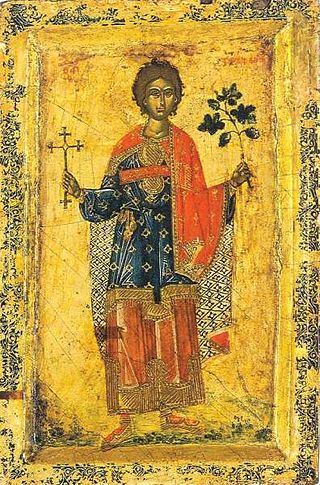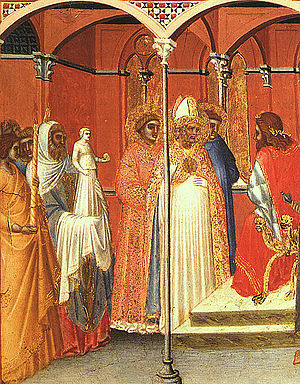
Pope Lucius I was the bishop of Rome from 25 June 253 to his death on 5 March 254. He was banished soon after his consecration, but gained permission to return. He was mistakenly classified as a martyr in the persecution by Emperor Valerian, which did not begin until after Lucius' death.
Pope Marcellinus was the bishop of Rome from 30 June 296 to his death in 304. A historical accusation was levelled at him by some sources to the effect that he might have renounced Christianity during Emperor Diocletian's persecution of Christians before repenting afterwards, which would explain why he is omitted from lists of martyrs. The accusation is rejected, among others, by Augustine of Hippo. He is today venerated as a saint in the Catholic Church and in the Serbian Orthodox Church.
Pope John I was the bishop of Rome from 13 August 523 to his death. He was a native of Siena, in Italy. He was sent on a diplomatic mission to Constantinople by the Ostrogoth King Theoderic to negotiate better treatment for Arians. Although John was relatively successful, upon his return to Ravenna, Theoderic had him imprisoned for allegedly conspiring with Constantinople. The frail pope died of neglect and ill-treatment.

The calendar of saints is the traditional Christian method of organizing a liturgical year by associating each day with one or more saints and referring to the day as the feast day or feast of said saint. The word "feast" in this context does not mean "a large meal, typically a celebratory one", but instead "an annual religious celebration, a day dedicated to a particular saint".

Saint Valentine was a 3rd-century Roman saint, commemorated in Western Christianity on February 14 and in Eastern Orthodoxy on July 6. From the High Middle Ages, his Saints' Day has been associated with a tradition of courtly love. He is also a patron saint of Terni, epilepsy and beekeepers. Saint Valentine was a clergyman – either a priest or a bishop – in the Roman Empire who ministered to persecuted Christians. He was martyred and his body buried on the Via Flaminia on February 14, which has been observed as the Feast of Saint Valentine since at least the eighth century.

Saint Publius is a first century Maltese bishop. He is venerated as the first Bishop of Malta and one of the first Bishops of Athens.

Saint Tryphon of Campsada was a 3rd-century Christian saint. He is venerated by the Roman Catholic and Eastern Orthodox churches as a great martyr and holy unmercenary.

Saints Cyprian and Justina are honored in the Catholic Church, Eastern Orthodox Church and Oriental Orthodoxy as Christians of Antioch, who in 304, during the Diocletianic Persecution, suffered martyrdom at Nicomedia on September 26. According to Roman Catholic sources, no Bishop of Antioch bore the name of Cyprian.

Saints Justa and Rufina (Ruffina) (Spanish: Santa Justa y Santa Rufina) are venerated as martyrs. They are said to have been martyred at Hispalis (Seville) during the 3rd century.

Saints Cyrus and John are venerated as martyrs. They are especially venerated by the Coptic Church and surnamed Wonderworking Unmercenaries because they healed the sick free of charge.
Acepsimas of Hnaita was a bishop, martyr and saint.

Benjamin was a deacon martyred circa 424 in Persia. Benjamin was executed during a period of persecution of Christians that lasted forty years and through the reign of two Persian kings: Isdegerd I, who died in 421, and his son and successor, Varanes V. King Varanes carried on the persecution with such great fury that Christians were submitted to the most cruel tortures.

The 20,000 Martyrs of Nicomedia refers to victims of persecution of Christians in Nicomedia, Bithynia by the Roman Emperors Diocletian and Maximian in the early 4th century AD.
Jason of Thessalonica was a Jewish convert and early Christian believer mentioned in the New Testament in Acts 17:5–9 and Romans 16:21.

October 24 - Eastern Orthodox liturgical calendar - October 26

November 17 - Eastern Orthodox liturgical calendar - November 19

December 9 - Eastern Orthodox liturgical calendar - December 11

December 29 - Eastern Orthodox liturgical calendar - December 31

March 15 - Eastern Orthodox liturgical calendar - March 17

The Martyrs of Persia under Shapur II were Assyrian Christian martyrs who were put to death by Shapur II of Persia for failing to renounce their faith. There may have been several thousand in total. They are remembered as a group in the Roman and Orthodox calendars. The Roman Martyrology gives feast days of 6 April, 22 April and 9 May for different groups.












